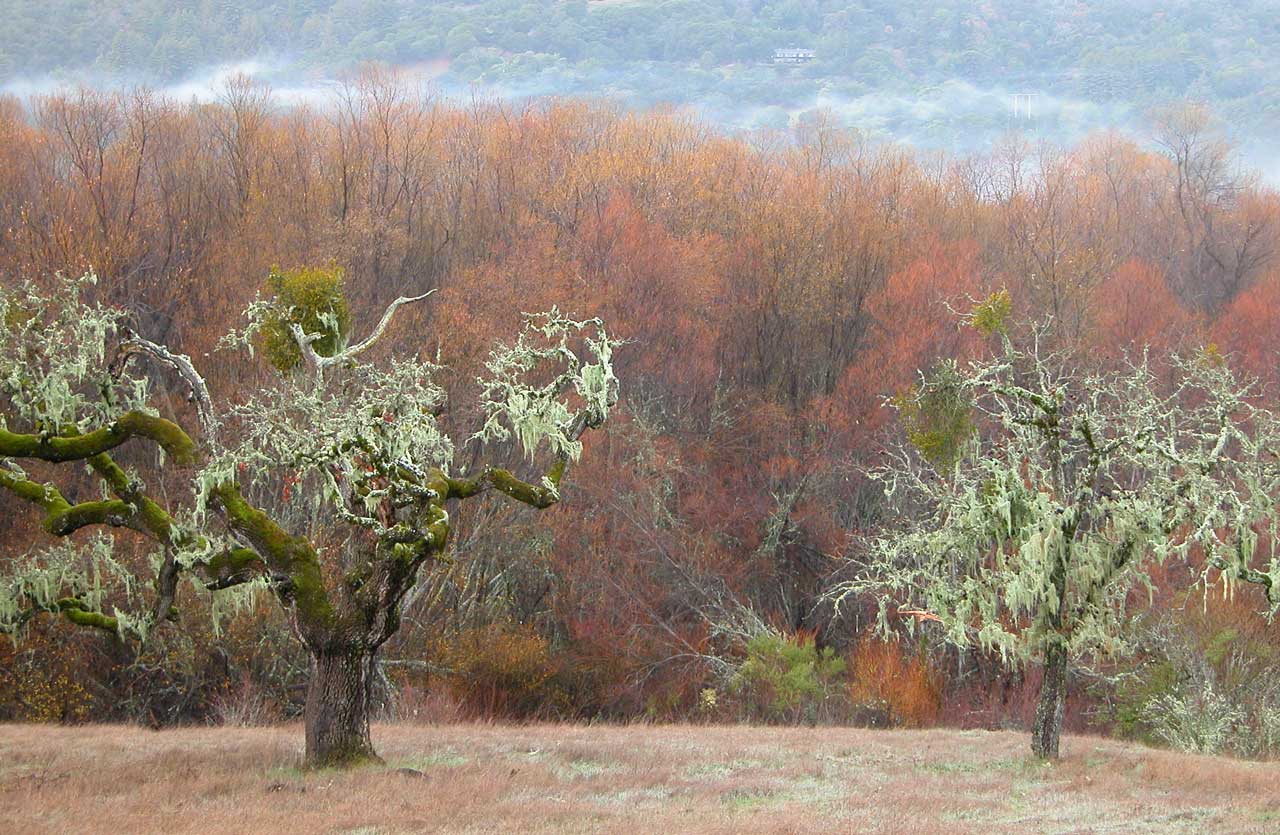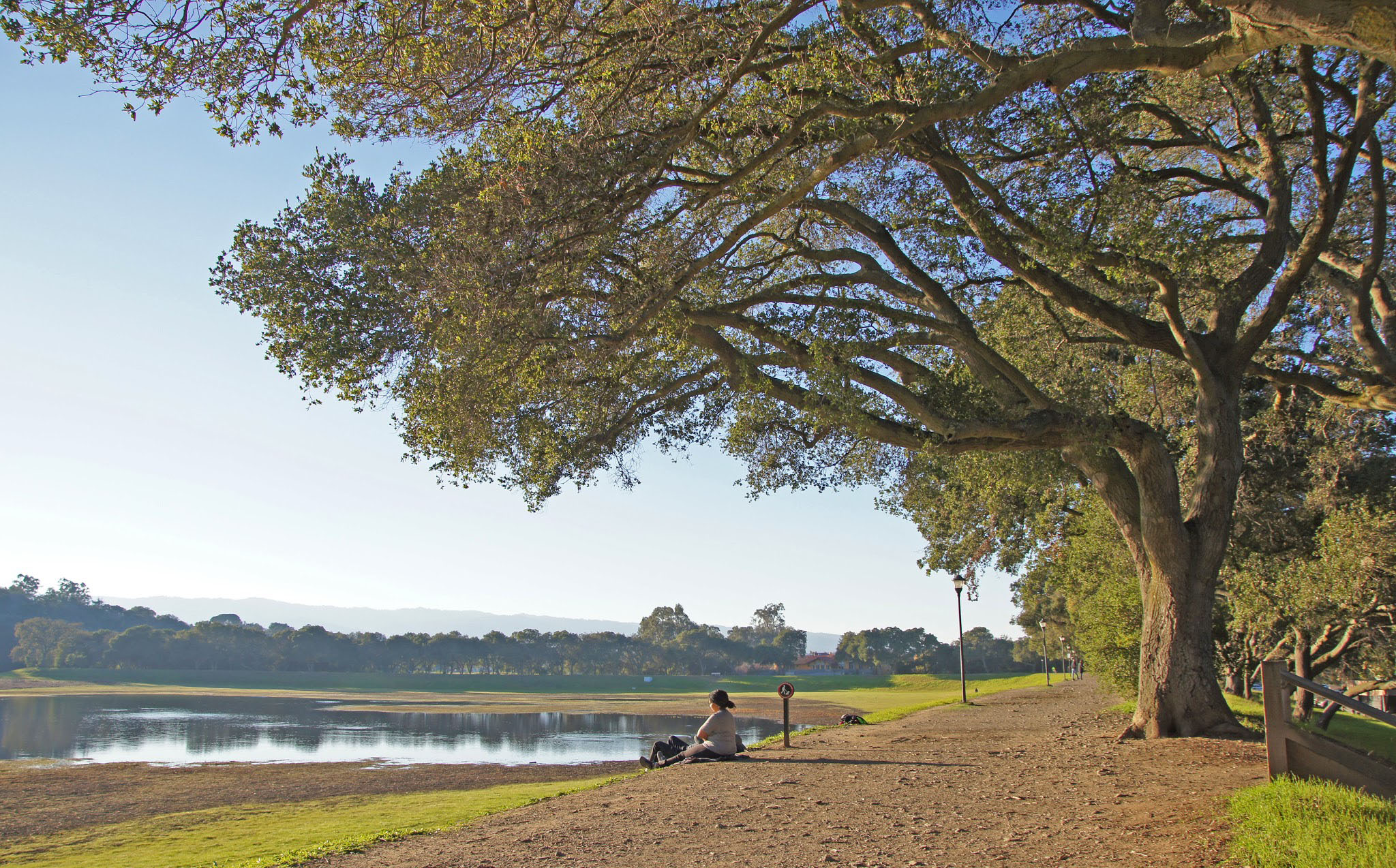Quercus (Oak) Notes

Having evolved a root system capable of sustaining a large tree in soil that receives no summer rain, the coast live oak regrettably succumbs to (edible) oak root fungus (Armillaria, the honey fungus) if watered. The striking phenomenon of old giants dropping dead in the middle of the green lawns of new developments has been witnessed in neighboring communities year after year with monotonous regularity. The reputation of coast live oak wood as fuel is unmatched and, for better or worse, is in ample supply.
The coast live oak also nurtures the oak moth caterpillars that descend on silk threads in spring. In some years they defoliate the trees, giving forth a sound like light rain. The trees recover but the oak moth can be controlled with Dipel, Thuricide, or Biotrol, sprays containing Bacillus thuringiensis, a bacterium that in nature is parasitic on specific larvae. The idea that a species of insect can cohabit with a tree host for millions of years, adapting slowly so that today it can live only on that host, suggests that there may be a benefit to the tree. There may be a third party involved, maybe a bird or a soil organism or something else.
Sudden oak death syndrome in the California and Oregon coastal regions, which by 2002 had reached the Bay Area, is a killer mold (Phytophthora ramorum), reminiscent of Dutch elm disease and other fatal scourges. It is known to affect black oak, coast live oak, and tan oak, having killed tens of thousands; whether it can kill redwoods is a current concern, and resources have been insufficient to survey the situation. The risk in planting local natives that may succumb to local pests is mitigated by the universal practice of bringing new species of trees in from outside; but sometimes the exotic pests are not far behind. The innumerable old coast live oaks of the Palo Alto area are all about the same age, which suggests that they descend from survivors of a previous generation that suffered a catastrophe long ago. Whether fungus, insect, freeze, drought, or fire was responsible is not known; consequently there is no clear answer to what current planting policy should be, nor is it clear who will formulate policy, forest pathologists being in short supply. We can guess what future practice will be – Palo Altans will keep planting Quercus agrifolia.
The savanna of coast live oaks, valley oaks, and blue oaks supported by the Stanford foothills has been under study since the 1980s by David Schrom and Joan Schwan of Magic in collaboration with Stanford and with the participation of community residents. This kind of volunteer activity offers an opportunity to involve students. A student-propelled group drawing on the Arbor Day or Canopy organizations for background could conduct its own discussions on which species they like and how to mesh with Facilities Operations as to where planting might be feasible. Oaks that are one or two centuries old predominate. Those over two centuries old are less numerous, as is understandable from the dead skeletons that are still standing and the decaying piles left from years ago. Of concern, however, is the deficit of younger trees as compared with what there must have been 100 years ago. The blue oak is the most threatened of the three.
A good many seedlings are lost because cattle graze the hills, taking anything that is green in the dry season. They also make it difficult for acorns to germinate under parent trees by packing down the soil in the shade where they lie down. Therefore cattle-free zones have been established. Positive action by planting acorns is also under way. In areas where there are cattle, protective cages can be used but the cage has to be robust enough to support a leaning cow scratching its hide. Above-ground attack by rodents wishing to gnaw through the bark at ground level has to be resisted by wire mesh finer than the size of a mouse, while attack by underground rodents requires mesh basketry penetrable by roots only. By the year 2000, over 2000 trees had been established, mostly from direct seed planting.
The experience gained by this enterprise will be of wider use in the effort to preserve the characteristic rolling-hill scenery of open savanna associated with much of California and widely appreciated by the population. To deter the Spanish oats from sucking up the moisture that the oak seedling needs a black plastic sheet may be put down and covered with the wood chips that are available from shredding operations on the university grounds. This is effective in producing an opening in the oat cover but proved to be a serious setback when the major ground fire of 1995 occurred. The lesson learned was to substitute river pebbles for wood chips – heavier work for the volunteers! Why not join them and meet a healthy class of people?
A four-year effort to count the oaks in Palo Alto concluded in 2002 that there were 11,000 coast live oaks and 2000 valley oaks, while blue oaks and black oaks totaled 100 or so. The largest, with an 80-inch diameter, was a coast live oak. The Rinconada Oak, a coast live oak and Palo Alto heritage tree, is 75 feet high, is 52 inches in diameter, has a spread of 120 feet, and is more than 200 years old. Marked with a plaque, it is located in front of the swimming pool building on the Embarcadero Road side of Rinconada Park. The coast live oak is represented on the seal of the City of Menlo Park.
Acorns were a significant part of the diet of the Native Americans. Because of their tannic acid content, which makes them bitter to humans, acorns need to be leached. This leaching was typically done after the acorns, relieved of their shells, had been ground into meal. Experts cite records of an alternative treatment practised by the “Shasta Indians” (using primarily acorns of Quercus chrysolepis) of burying acorns in swampy ground for a year. When dug up they were purplish in color and were roasted and eaten whole. Another treatment (also cited in EK Bold, 1962, Early Uses of California Plants, Berkeley: UC Press, pp. 11–12) was the practice of leaving shelled acorns to mold in a basket and then burying them in clean river sand until they turned black, at which point they ready for use. Acorn meal can be prepared in many different ways, as can be found today from one end of the Mediterranean to the other. The world’s acorn harvest now exceeds that of all other nuts taken together, and is consumed mainly by pigs.
Did you know that Encina Hall, that well-known Stanford landmark, is a monument to the coast live oak? Stanford’s tribute to the valley oak is preserved in the names Roble Field, Roble Hall Center, Roble Gym, and Roble Pool.
In a telegram sent to David S. Jordan dated May 16, 1891, Leland Stanford wrote:
I approve the proof sheets of your prospectus but have decided to name the dormitories after live oak and white oak which are the principal natural trees of this valley. For the boys dormitory Encina Hall and for the girls dormitory Robles Blancho [sic] Hall, being the Spanish names for the live oak and the white oak.
The main oaks native to California are Q. agrifolia, chrysolepis, douglasii, durata, engelmannii, garryana, kelloggii, lobata, × morehus, palmeri, parvula, sadleriana, tomentella, and wislizeni, of which six or so are described here. In addition, Stanford has several oaks from outside California (coccinea, macrocarpa, palustris, rubra, virginiana) and some from overseas (cerris, ilex, robur, suber).
Several oak species new to campus, or rarely seen here, were planted in 2003 by Magic, Inc., of Palo Alto. The plants were small, and in some cases only acorns: Q. calliprinos (Palestine oak), Q. engelmannii (Engelmann oak), and Q. parvula var. shrevei (Shreve oak). Three Mexican oak acorns also were planted, Q. greggii, Q. diversifolia, and Q. mexicana, though it is unclear if any of these survived.
There is extensive hybridization among oaks. The current treatment of native oaks can be found online in the Jepson eFlora.
Oak classification
These notes are based on the latest classification of oaks:
Denk, T., Grimm, G.W., Manos, P.S., Deng, M., Hipp, A.L. (2017). An Updated Infrageneric Classification of the Oaks: Review of Previous Taxonomic Schemes and Synthesis of Evolutionary Patterns.
Quercus subgenus Quercus
New World, high-latitude clade. Mainly in Americas, some Eurasia & north Africa.
section Lobatae: red oaks
- native to North, Central and South America.
- Styles long, acorns mature in 18 months (rarely 8 months – agrifolia), very bitter, inside of acorn shell woolly
- Cupule fused with peduncle forming a connective piece, which along with the cupule is covered with thin membraneous triangular scales with broad angled tips
- Leaves: teeth with bristle extensions, or just bristles without teeth
- Examples: agrifolia, wislizeni, kelloggii; nigra, palustris, canbyi, shumardii, hypoleucoides, rubra, etc.
- Southwest USA and northwest Mexico
- Styles short, acorns mature in 18 months, very bitter, inside of acorn shell woolly
- Only 5: chrysolepis, palmeri, tomentella, cedrosensis, vacciniifolia
- Only 2: sadleriana (N Calif, S Oregon), pontica (Turkey/Georgia)
- virginiana, etc.
- white oaks from Europe, Asia, north Africa, Central and North America
- Styles short; acorns mature in 6 months, sweet or slightly bitter, inside of acorn shell hairless
- Cupule scales have keels & often covered with bumps (tuberculate)
- No spines or bristles on teeth (but many exceptions, e.g. berberidifolia, dumosa, durata)
- lobata, garryana, douglasii, engelmannii, oblongifolia, berberidifolia, dumosa, durata; macrocarpa, alba, robur, etc.
Quercus subgenus Cerris
Old World, mid-latitude clade. Mainly in Eurasia, some N Africa.
sect. Cyclobalanopsis: ring-cupped oaks
- E & SE tropical Asia
- Distinctive cupules bearing concrescent rings of scales
- Styles medium-long; acorns mature in 12–24 months, appearing hairy on the inside. Evergreen leaves, with bristle-like extensions on the teeth
- ilex, rotundifolia, coccifera/calliprinos,
- Europe, north Africa and Asia.
- Acorn cup scales elongated with recurved tips; styles long; acorns mature in 18 months, very bitter, inside of acorn shell hairless or slightly hairy.
- suber, cerris, castaneifolia, ithaburensis, trojana
Illustrations: Oak Gallery.
Name derivation: Quercus – classical Latin name for the oak, possibly derived from the Celtic quer, fine; and cuez, tree [from California Plant Names].
About this Page: The main text is from the book Trees of Stanford and Environs, by Ronald Bracewell, published 2005. Additional notes on acorn preparation and recent plantings by Magic added by John Rawlings c. 2005. Classification section added (Sep 2024, SP).




